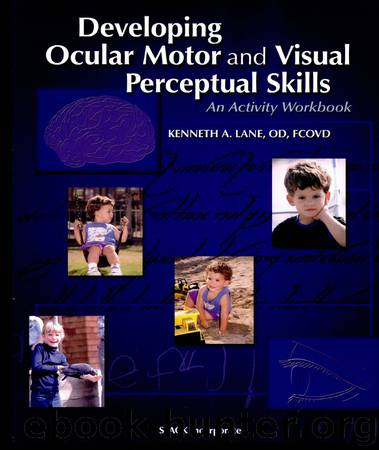Developing Ocular Motor and Visual Perceptual Skills by Kenneth A. Lane

Author:Kenneth A. Lane
Language: eng
Format: epub
Publisher: DCL
Figure 6-1. Poor organization on page.
There are several factors that exacerbate motor memory problems. The first two factors always indicate dysgraphia and the last two factors by themselves rarely indicate dysgraphia.
1. Weak kinesthetic memory so that an accurate pattern is not stored.
2. Poor ability to express written ideas with clarity and in sequence, especially when the student is more efficient when verbally expressing clear, sequential ideas.
3. Generalized memory or sequencing weakness.
4. Weak or inconsistent ability to recall visual and motor movement sequences.
5. Inexperience due to lack of practice involving consistent repetition of the pattern.
6. Lack of experience due to attentional problems (Richards, 1999).
Dysgraphia is a problem that is not due to attentional problems or lack of practice. Handwriting that is sloppy and disorganized deteriorates over the years and becomes practically illegible because of changes in structural performance. Dysgraphic handwriting shows poor structural performance from the beginning. The differences between dysgraphic and nondysgraphic handwriting are the largest in grade two (Hamstra-Bletz, 1990). Keep in mind that just as dyslexic readers are poor readers from the beginning, dysgraphic writers are poor writers from the beginning. Dysgraphia is not the result of poor instruction or lack of training (Van Galen, 1993).
Poor handwriting is one of the most frequent reasons that school aged children are referred to occupational therapy (Fisher, 1991). Ten to 20% of primary school children have dysfunctional handwriting, and among those 66% are boys (Karlsdottir, 1996). Handwriting goes through several stages, with the mastery of most forms and some manuscript letters in preschool and kindergarten to mastery of upper and lower case manuscript in grades one to the beginning of two. In grades two to four, cursive writing is introduced (Richards, 1999). There is initially fast improvement in handwriting in first and second grades; however, the quality of handwriting tends to stagnate after third grade (Karlsdottir, 2002). Initially, the size of handwriting becomes smaller over time (especially boys), the word and letter alignment improves, the writing trace becomes steadier, and the lines are smooth. Girls are ahead of boys in development. Later on, when formal instruction in handwriting has stopped, the handwriting changes and some deterioration of form starts to develop (Hamstra-Bletz, 1990). From fourth grade on, children start to use easier movement patterns that require less effort. In addition, in higher grades, the script becomes larger, joins between letters are often omitted, and the letters are placed very closely together (Hamstra-Bletz, 1990).
It appears that most improvements in handwriting occur over the first three grades. In fact, children with functional handwriting at the end of first grade don't make any significant improvements in their handwriting during the higher grades. Good handwriters reach their permanent level in handwriting during grades one and two, while poor writers learn at a slower rate (Karlsdottir, 1996). For handwriting to be easily legible, at least 50 percent of the letters must be mastered, and this takes place in grades one and two. The equality of children's handwriting should be expected to develop quickly during grade one and reach its permanent level during grade two.
Download
This site does not store any files on its server. We only index and link to content provided by other sites. Please contact the content providers to delete copyright contents if any and email us, we'll remove relevant links or contents immediately.
| Anesthesiology | Colon & Rectal |
| General Surgery | Laparoscopic & Robotic |
| Neurosurgery | Ophthalmology |
| Oral & Maxillofacial | Orthopedics |
| Otolaryngology | Plastic |
| Thoracic & Vascular | Transplants |
| Trauma |
When Breath Becomes Air by Paul Kalanithi(7253)
Why We Sleep: Unlocking the Power of Sleep and Dreams by Matthew Walker(5637)
Paper Towns by Green John(4163)
The Immortal Life of Henrietta Lacks by Rebecca Skloot(3820)
The Sports Rules Book by Human Kinetics(3581)
Dynamic Alignment Through Imagery by Eric Franklin(3482)
ACSM's Complete Guide to Fitness & Health by ACSM(3459)
Kaplan MCAT Organic Chemistry Review: Created for MCAT 2015 (Kaplan Test Prep) by Kaplan(3418)
Introduction to Kinesiology by Shirl J. Hoffman(3297)
Livewired by David Eagleman(3115)
The River of Consciousness by Oliver Sacks(2989)
Alchemy and Alchemists by C. J. S. Thompson(2908)
The Death of the Heart by Elizabeth Bowen(2896)
Descartes' Error by Antonio Damasio(2728)
Bad Pharma by Ben Goldacre(2722)
The Gene: An Intimate History by Siddhartha Mukherjee(2488)
Kaplan MCAT Behavioral Sciences Review: Created for MCAT 2015 (Kaplan Test Prep) by Kaplan(2484)
The Fate of Rome: Climate, Disease, and the End of an Empire (The Princeton History of the Ancient World) by Kyle Harper(2429)
The Emperor of All Maladies: A Biography of Cancer by Siddhartha Mukherjee(2427)
